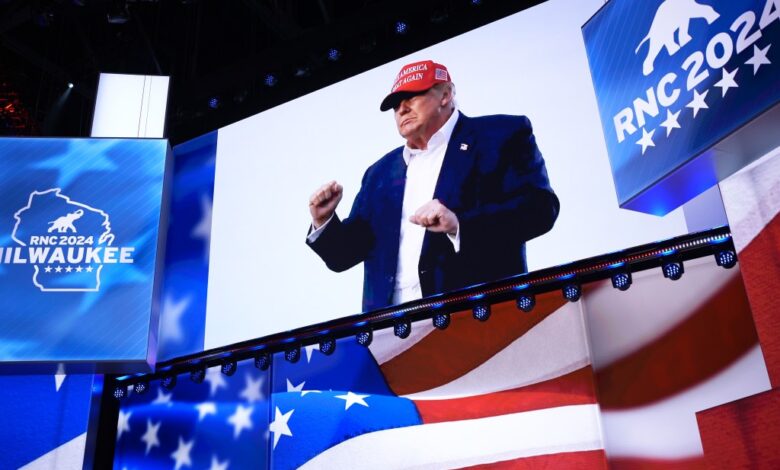How safe will Milwaukee RNC be after Trump shooting?

Ripples from Saturday’s attempted assassination of former President Donald Trump in Butler, Pa., are being felt deeply some 550 miles away in Milwaukee, site of this week’s Republican National Convention. President Biden announced the investigation of a 20-year-old shooter’s apparent breach of a US Secret Service security perimeter at a Trump rally will be thorough, exhaustive and “independent.”
But post-incident shooting reviews are complex and take time. Congress and the American people did not get answers before the convention started Monday. Just how heightened will security measures be at the RNC? If history is an indicator, seismic shifts in posture and alertness should be underway.
I understand this paradigm transformation because 20 years ago, when we were only three years removed from the horrors and colossal intelligence failures of 9/11, the Republican National Committee was set to hold its convention at Madison Square Garden. And some of the intercepted chatter from terrorist groups mentioned pursuit of the “next 9/11.” What more attractive target than a venue hosting a sitting US president in America’s most iconic city? The stakes were high and concerns of an imminent attack palpable in August 2004.
Serving then as the FBI New York office’s senior SWAT team leader of a 45-man tactical unit, my charge was to interface with the Secret Service and the NYPD and ensure tactical operations were integrated and seamless.
No easy feat even considering modest post-9/11 interagency communications improvements.
This advance coordination was like what the Secret Service assuredly engaged in with state and local law-enforcement agencies before Saturday’s campaign rally in Butler. The USSS must leverage sister law-enforcement agencies and assets to buttress its mission and effect its charge to protect the president.
When the Homeland Security secretary designates a particular event — such as one of the two major political parties’ conventions — a National Special Security Event, the Secret Service “assumes its mandated role as the lead agency for the design and implementation of the operational security plan.” Per doctrine, a typical candidate campaign rally like Trump’s would not be a designated NSSE. This means the equipment and personnel resources allocated to Butler, were far more limited than what we will see available and on display in Milwaukee.
The FBI’s role during an NSSE such as the 2004 or 2024 RNC is distinctly different. With Presidential Decision Directive 62, a communication related to national security and US foreign policy, the Clinton administration granted the Department of Justice (via the FBI) lead-agency status to act as operational-response authority to any terror attack; to wit, an attack on the president or delegates at this convention.
Application of “lessons learned” is coin of the realm for law enforcement seeking to minimize “blind spots” during security evaluations. After President John F. Kennedy’s 1963 assassination in Dallas came sober realization of the deadly consequence of a trained sniper with a commanding vantage point above a presidential motorcade — no longer an abstraction.
Future US presidents’ public appearances necessitated adherence to the military adage that commands “own the high ground.” What a glaring security lapse that allowed Thomas Matthew Crooks to assume his perch atop a building some 130 yards away from Trump Saturday. This concern’s not an issue in Milwaukee, as the event is indoors in a smaller, easier-to-control space.
But just what will be the necessary adjustments in coordination and operations for Milwaukee?
First, President Biden already announced an increase in resources to his predecessor’s USSS detail, which Rep. Mike Waltz (R-Fla.) alleges the campaign had already requested and been denied. Anticipate the largest USSS footprint in modern history in Milwaukee. Robust, public visible positioning of security assets can serve as a deterrent effect.
Next, expect emergent technologies such as facial recognition deployed to control access and identify potential threats as law-enforcement agencies across the nation mine data from social-media sites and investigate threats posted online. Advanced, cutting-edge surveillance technology, including drones, sensors and cameras provided to local law enforcement in advance of Milwaukee-hosted Democratic National Convention in 2020 are already in place.
Interoperability of communications devices (read: radios) among the multitude of law-enforcement agencies will also be of paramount concern. During a crisis incident, having everyone on the same radio-frequency channel is untenable.
But every single post-incident after-action-review of a crisis event I led included lamentations about “not being able to talk to one another.” This issue will certainly be a subject of the assassination attempt evaluation. No doubt the Secret Service will ensure a fusion center or joint-operations center focuses on comms.
Last: In 1995, shortly after an extremist bombed Oklahoma City’s Alfred P. Murrah Federal Building, FBI Director Louis Freeh assigned additional agent resources to protective detail for Attorney General Janet Reno.
As one of those young FBI agents assigned this temporary duty, I recall the briefing I received from the senior agent in command. He simply warned, “Complacency kills.”
The often boring and mundane nature of surveillance assignments and protection missions leads to complacency. Sometimes it takes a rather jarring event like Saturday’s tragedy and near-miss to sharpen the senses and keep us alert.
Make no mistake — Milwaukee’s Fiserv Forum will be the safest venue on the planet this week. As the nation seeks answers to the failings in Butler, Pa., heightened awareness will be the margin of victory against evil.
James A. Gagliano is a retired FBI supervisory special agent and doctoral candidate in homeland security at St. John’s University. He serves as mayor of Cornwall-on-Hudson, NY, and on the Law Enforcement Legal Defense Fund board of directors.




